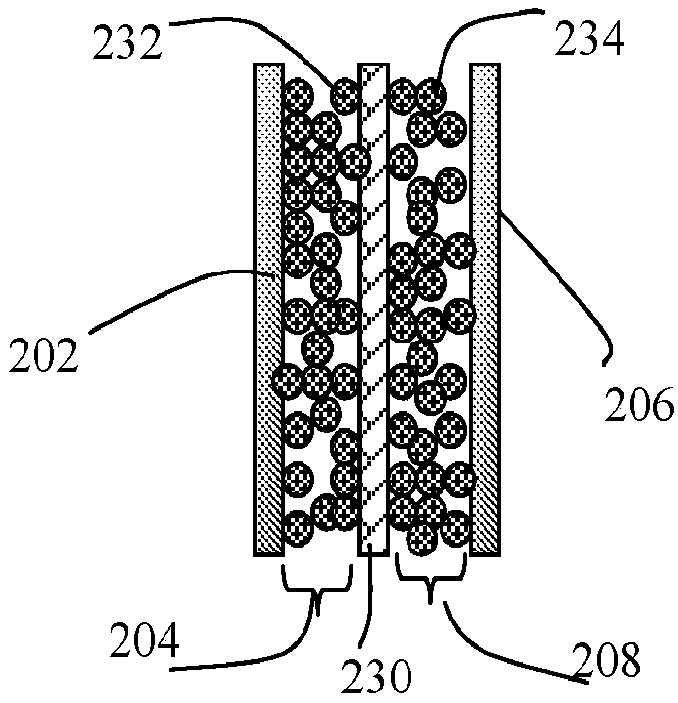Supercapacitor having a highly conductive graphene foam electrode
一种超级电容器、石墨烯泡沫的技术,应用在石墨烯、电容器、混合电容器等方向,能够解决昂贵、不能提供具有高容量的能量储存装置、高度不希望等问题
- Summary
- Abstract
- Description
- Claims
- Application Information
AI Technical Summary
Problems solved by technology
Method used
Image
Examples
example 1
[0175] Example 1: Various blowing agents and methods of forming cells (generating air bubbles)
[0176] In plastics processing, chemical blowing agents are mixed into plastic pellets in powder or pellet form and dissolved at elevated temperatures. Above a certain temperature specified for the dissolution of the blowing agent, gaseous reaction products (usually nitrogen or CO 2 ), which acts as a blowing agent. However, chemical blowing agents are not soluble in graphene materials, which are solids rather than liquids. This presents a challenge for generating pores, or cells, in graphene materials using chemical blowing agents.
[0177] After extensive experimentation, we found that almost any chemical blowing agent (eg in powder or pellet form) can be used to generate pores or bubbles in the dry graphene layer when the first heat treatment temperature is sufficient to activate the blowing reaction. A chemical blowing agent (powder or pellet) can be dispersed in a liquid med...
example 2
[0182] Example 2: Preparation of Discrete Nanographene Platelets (NGPs) as GO Sheets
[0183] Chopped graphite fibers and natural graphite particles with an average diameter of 12 μm were used alone as starting materials, which were immersed in a mixture of concentrated sulfuric acid, nitric acid, and potassium permanganate (as chemical intercalants and oxidizing agents) to prepare graphite Intercalation Compounds (GICs). The starting material was first dried in a vacuum oven at 80 °C for 24 h. Then, under proper cooling and stirring, a mixture of concentrated sulfuric acid, fuming nitric acid, and potassium permanganate (in a weight ratio of 4:1:0.05) was slowly added to the three-necked flask containing the fiber fragments. After 5-16 hours of reaction, the acid-treated graphite fibers or natural graphite particles were filtered and washed thoroughly with deionized water until the pH level of the solution reached 6. After drying overnight at 100°C, the resulting graphite i...
example 3
[0187] Example 3: Preparation of single-layer graphene sheets by mesocarbon microspheres (MCMB)
[0188] Mesocarbon microspheres (MCMB) were supplied by China Steel Chemical Co., Kaohsiung, Taiwan. This material has about 2.24g / cm 3 density and a median particle size of about 16 μm. MCMB (10 g) was intercalated with acid solution (4:1:0.05 ratio of sulfuric acid, nitric acid, and potassium permanganate) for 48-96 hours. When the reaction was complete, the mixture was poured into deionized water and filtered. The intercalated MCMB was repeatedly washed in 5% HCl to remove most of the sulfate ions. The samples were then washed repeatedly with deionized water until the pH of the filtrate was not lower than 4.5. The slurry was then subjected to sonication for 10-100 minutes to produce a GO suspension. TEM and AFM studies show that most of the GO sheets are single-layer graphene when the oxidation treatment exceeds 72 h, and two- or three-layer graphene when the oxidation time...
PUM
| Property | Measurement | Unit |
|---|---|---|
| density | aaaaa | aaaaa |
| aperture size | aaaaa | aaaaa |
| density | aaaaa | aaaaa |
Abstract
Description
Claims
Application Information
 Login to View More
Login to View More - R&D
- Intellectual Property
- Life Sciences
- Materials
- Tech Scout
- Unparalleled Data Quality
- Higher Quality Content
- 60% Fewer Hallucinations
Browse by: Latest US Patents, China's latest patents, Technical Efficacy Thesaurus, Application Domain, Technology Topic, Popular Technical Reports.
© 2025 PatSnap. All rights reserved.Legal|Privacy policy|Modern Slavery Act Transparency Statement|Sitemap|About US| Contact US: help@patsnap.com



